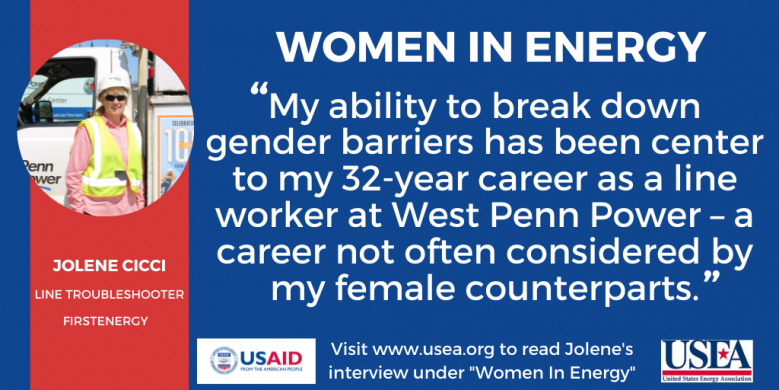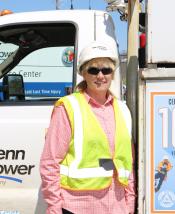
Women In Energy: Jolene Cicci
The Women in Energy series is a joint project between USEA and USAID that was developed out of USEA’s Engendering Utilities Partnership, a program funded by USAID to improve gender policies and gender outcomes at their respective organizations.

Every month we feature a woman who has shown exemplary leadership. We want to showcase your story this month. The women among you come from diverse backgrounds and roles, and they bring with them a unique perspective to gender equality within the energy sector.

Jolene Cicci is the only female line worker for West Penn Power, a subsidiary of FirstEnergy. Line workers are responsible for building, maintaining and restoring electrical service – often during inclement weather or following an accident that has damaged electrical equipment. With more than 30 years of experience in line work, Cicci is committed to recruiting more women to take on this challenging yet rewarding career long dominated by men.
*USEA does not alter the substance of the responses from the women featured. The answers are their own.
Women in Energy Interview Questions
How have your education and career path led you to where you are now?
“I began my career working in a power plant on the generation side of the energy business where, at the time, I was the only woman working at the plant. Shortly after, this position opened the door for me to become a line worker at the company. I was able to transfer to the distribution side of the company and, after a five-year period that included schooling and testing, I became a top performing line worker and, ultimately, a lead line worker.
Currently only 1% of line workers in the country are women. I believe many women shy away from this profession because of the physical aspect of the job. My training was rigorous, as well as physically and mentally challenging. Even for a man in good physical condition, climbing a pole with heavy equipment is no small feat. With lots of practice—and patience—I discovered new techniques for climbing that were more fitting for women.
Throughout my career, many peers have looked at me and assumed I was a supervisor or engineer because they couldn’t believe I was a line worker. I have been able to win over my co-workers with my work ethic and passion for line work. My ability to break down gender barriers has been center to my 32-year career as a line worker at West Penn Power – a career not often considered by my female counterparts.
My parents always instilled in us that if you want to do something, don’t let barriers stand in the way of following your dreams – it’s all about who you are and what you bring. Line work is a very dangerous and rigorous job, but it can be a very rewarding career for anyone. My greatest satisfaction is getting the lights back on!”
Over the course of your career, have you witnessed changes in the sector that have launched more women into leadership positions?
“When I started my career in 1989, there were very few female leaders. As I reflect on my career, tremendous progress has been made, and I am proud to work for a company that values Diversity & Inclusion.
Programs and resources like employee business resource groups (EBRGs) have been instrumental in supporting the advancement of women in the energy industry. I am a member of FirstEnergy’s Women in Leadership EBRG, which is dedicated to developing current and future women leaders for leadership positions and addressing the challenges of work/life balance. My role is recruitment and retention of women and diverse candidates in the line worker field, which includes speaking engagements and recruiting efforts for our Power Systems Institute (PSI) training program.
The world has changed and evolved in the past three decades with the focus on Diversity & Inclusion, and I look forward to seeing women continue to advance and take on new roles in our industry.”
Technology is transforming the traditional utility business model into a more modern interactive grid. Some utilities view this transformation as an opportunity to focus on change management and diversity. Research provides compelling evidence that inclusion and diversity unlock innovation and drives better business performance. What, if anything, is your organization doing to attract, retain, and promote more women into senior management positions to respond to the dramatic industry transformation?
“Diversity & Inclusion is a core value for FirstEnergy. It’s the foundation for everything we do so we can better serve our customers and provide a rewarding and inclusive work experience for all employees.
FirstEnergy is committed to attracting a diverse pool of candidates for every open position. This begins with our college recruiting efforts for both our Power Systems Institute (PSI) training program for line workers and substation electricians, as well as our award-winning Co-op/Intern Program. While we are still working to increase awareness of line worker and substation electrician opportunities among female candidates, the number of women in our Co-op/Intern Program has more than doubled over the previous five years. When hiring externally for senior management positions, we work with executive search partners that focus on diversity.
To leverage employees' enthusiasm and their affiliations to expand FirstEnergy’s external partnerships with diverse professional organizations, universities and colleges, the company recently established the FirstEnergy Ambassador Network. The Ambassador Network is a volunteer-based employee program to develop and grow talent pipelines, helping us to foster relationships with key professional organizations like the Society of Women Engineers (SWE).
Additionally, FirstEnergy has a well-developed succession process to prepare women to advance, develop and grow to achieve the career levels they aspire to. This includes having candid, meaningful career conversations where employees can share their career aspirations and leaders can assist employees with creating a strong development plan while providing feedback and coaching.”
Are talented women within your organization making it to top leadership positions? Why/why not?
“Like our other business goals, advancing women in leadership is a focus area for FirstEnergy. That’s why we establish five-year goals for our hiring and leadership pipeline. According to our Human Resources (HR) department, the percentage of women in our workforce increased from 20.8 percent in 2015 to 22.2 percent in 2020. The number of women in leadership positions across the organization has also grown to 22.3 percent, which exceeds the general industry comparison for our region at 21.4 percent. Additionally:
- Women make up 30 percent of FirstEnergy’s Board of Directors
- Women make up 30 percent of FirstEnergy’s Executive Council, which includes the top 10 leaders
- Women make up 24 percent of FirstEnergy’s Leadership Council, which includes the top 75 leaders
I am proud to see the representation of women in leadership positions increase, and I am pleased that the company is focusing on our talent development processes to ensure women have opportunities to serve in our company’s top positions.
While low turnover and attrition in the top positions in the company contribute to the number of opportunities available to both men and women, experience in areas like revenue operations and utility operations can impact an employee’s consideration for those positions. That’s why FirstEnergy’s succession planning process includes identifying development opportunities and experiences for succession plan candidates to enhance their skillsets and address any potential experience gaps.”
Companies that embrace diversity outperform their competitors. What type of diversity programs does your organization have in place to mentor future women leaders? How does your organization measure and report gender diversity? Is the data publicly available?
“FirstEnergy has made significant strides in its Diversity & Inclusion initiatives, particularly in the types of programs available to help all employees advance in their careers. The company offers a formal mentoring program to connect women with other employees who can help them grow personally and professionally. In addition, two employee business resource groups (EBRGs) have been established to support the advancement of women at FirstEnergy. Women in Leadership, which I mentioned above, has four chapters across FirstEnergy’s service area. Helping Women GROW, which has three chapters, is focused on call center employees and offers its own mentoring program as well as opportunities for development and skill building. We are also piloting a college tuition reimbursement program specifically for call center employees to earn an associate degree.
To measure progress, FirstEnergy established a D&I Index that is focused on achieving our Diversity & Inclusion goals. The D&I Index is included in our annual short-term incentive compensation program and is applicable to FirstEnergy leaders, including the CEO. The Index measures our progress in expanding the diversity of our leadership pipeline through a focus on diverse professional hires and succession plan candidates. The D&I Index also includes the results of the annual D&I employee survey that measures our employees’ perspectives on our efforts to create a more diverse and inclusive work environment.
To measure all the steps in the talent lifecycle - from attracting talent to recruiting, hiring, developing, advancing and exiting – our HR department produces monthly scorecards for workforce data, hiring and attrition. The information is currently shared with leadership and FirstEnergy’s D&I Council. Work is underway to create greater transparency with a semi-annual D&I report in 2021.
In addition, FirstEnergy benchmarks with other companies and leading organizations to identify where we can continue to raise the bar on achieving our goals. Recently, FirstEnergy was included in the Bloomberg Gender-Equality Index (GEI) for the third consecutive year, recognizing the company’s investment in gender equity in the workplace and the communities in which we operate. The company also engages Aon to conduct pay equity audits that confirm FirstEnergy pays equitably based on both race and gender.”
What actions should the energy and electricity sector be focused on to accelerate change, increase diversity, and foster a better gender balance in the boardroom?
“Companies must consider D&I goals the same as other business goals. This helps to establish accountability across the organization, puts a focus on measuring progress and rewards achievement.
It will also be important for companies to continue to provide development experiences for women to help prepare them for advanced roles, especially if those roles are responsible for financial or operational performance. This includes exposure to leaders, both men and women, through mentoring and sponsorship programs, as well as developing established processes for succession planning and creating candidate and interview slates that give women a seat at the table.
Finally, to ensure your organization continues to foster gender equity, it’s important to learn from other companies and industries on how they accelerate workforce diversity and advancing women, while supporting professional organizations focused on advancing women in our industry.”
